Introduction to High-Level System Design
System Design Fundamentals
- Functional vs. Non-Functional Requirements
- Scalability, Availability, and Reliability
- Latency and Throughput Considerations
- Load Balancing Strategies
Architectural Patterns
- Monolithic vs. Microservices Architecture
- Layered Architecture
- Event-Driven Architecture
- Serverless Architecture
- Model-View-Controller (MVC) Pattern
- CQRS (Command Query Responsibility Segregation)
Scaling Strategies
- Vertical Scaling vs. Horizontal Scaling
- Sharding and Partitioning
- Data Replication and Consistency Models
- Load Balancing Strategies
- CDN and Edge Computing
Database Design in HLD
- SQL vs. NoSQL Databases
- CAP Theorem and its Impact on System Design
- Database Indexing and Query Optimization
- Database Sharding and Partitioning
- Replication Strategies
API Design and Communication
Caching Strategies
- Types of Caching
- Cache Invalidation Strategies
- Redis vs. Memcached
- Cache-Aside, Write-Through, and Write-Behind Strategies
Message Queues and Event-Driven Systems
- Kafka vs. RabbitMQ vs. SQS
- Pub-Sub vs. Point-to-Point Messaging
- Handling Asynchronous Workloads
- Eventual Consistency in Distributed Systems
Security in System Design
Observability and Monitoring
- Logging Strategies (ELK Stack, Prometheus, Grafana)
- API Security Best Practices
- Secure Data Storage and Access Control
- DDoS Protection and Rate Limiting
Real-World System Design Case Studies
- Distributed locking (Locking and its Types)
- Memory leaks and Out of memory issues
- HLD of YouTube
- HLD of WhatsApp
System Design Interview Questions
- Adobe System Design Interview Questions
- Top Atlassian System Design Interview Questions
- Top Amazon System Design Interview Questions
- Top Microsoft System Design Interview Questions
- Top Meta (Facebook) System Design Interview Questions
- Top Netflix System Design Interview Questions
- Top Uber System Design Interview Questions
- Top Google System Design Interview Questions
- Top Apple System Design Interview Questions
- Top Airbnb System Design Interview Questions
- Top 10 System Design Interview Questions
- Mobile App System Design Interview Questions
- Top 20 Stripe System Design Interview Questions
- Top Shopify System Design Interview Questions
- Top 20 System Design Interview Questions
- Top Advanced System Design Questions
- Most-Frequented System Design Questions in Big Tech Interviews
- What Interviewers Look for in System Design Questions
- Critical System Design Questions to Crack Any Tech Interview
- Top 20 API Design Questions for System Design Interviews
- Top 10 Steps to Create a System Design Portfolio for Developers
Introduction to High-Level System Design
System Design Fundamentals
- Functional vs. Non-Functional Requirements
- Scalability, Availability, and Reliability
- Latency and Throughput Considerations
- Load Balancing Strategies
Architectural Patterns
- Monolithic vs. Microservices Architecture
- Layered Architecture
- Event-Driven Architecture
- Serverless Architecture
- Model-View-Controller (MVC) Pattern
- CQRS (Command Query Responsibility Segregation)
Scaling Strategies
- Vertical Scaling vs. Horizontal Scaling
- Sharding and Partitioning
- Data Replication and Consistency Models
- Load Balancing Strategies
- CDN and Edge Computing
Database Design in HLD
- SQL vs. NoSQL Databases
- CAP Theorem and its Impact on System Design
- Database Indexing and Query Optimization
- Database Sharding and Partitioning
- Replication Strategies
API Design and Communication
Caching Strategies
- Types of Caching
- Cache Invalidation Strategies
- Redis vs. Memcached
- Cache-Aside, Write-Through, and Write-Behind Strategies
Message Queues and Event-Driven Systems
- Kafka vs. RabbitMQ vs. SQS
- Pub-Sub vs. Point-to-Point Messaging
- Handling Asynchronous Workloads
- Eventual Consistency in Distributed Systems
Security in System Design
Observability and Monitoring
- Logging Strategies (ELK Stack, Prometheus, Grafana)
- API Security Best Practices
- Secure Data Storage and Access Control
- DDoS Protection and Rate Limiting
Real-World System Design Case Studies
- Distributed locking (Locking and its Types)
- Memory leaks and Out of memory issues
- HLD of YouTube
- HLD of WhatsApp
System Design Interview Questions
- Adobe System Design Interview Questions
- Top Atlassian System Design Interview Questions
- Top Amazon System Design Interview Questions
- Top Microsoft System Design Interview Questions
- Top Meta (Facebook) System Design Interview Questions
- Top Netflix System Design Interview Questions
- Top Uber System Design Interview Questions
- Top Google System Design Interview Questions
- Top Apple System Design Interview Questions
- Top Airbnb System Design Interview Questions
- Top 10 System Design Interview Questions
- Mobile App System Design Interview Questions
- Top 20 Stripe System Design Interview Questions
- Top Shopify System Design Interview Questions
- Top 20 System Design Interview Questions
- Top Advanced System Design Questions
- Most-Frequented System Design Questions in Big Tech Interviews
- What Interviewers Look for in System Design Questions
- Critical System Design Questions to Crack Any Tech Interview
- Top 20 API Design Questions for System Design Interviews
- Top 10 Steps to Create a System Design Portfolio for Developers
From Upload to Play: Understanding YouTube’s Scalable Architecture
Quick Overview of What You’ll Learn
- YouTube’s global scale: 2.7 billion MAU, 122 million DAU, 1 billion hours watched daily, available in 100 countries/80 languages, 500 hours uploaded per minute
- Financial overview: $29.24 B ad revenue in 2022, with the U.S. video‑streaming market projected to reach $66.4 B by 2030, implying YouTube’s revenue could approach the $60 B range
- Core system components: CDN network, blob storage, transcoding pipeline (DAG), metadata DB (sharding + caching), API servers, load balancer
- Key workflows: chunked uploads with pre‑signed URLs, parallel DAG‑based transcoding, cache‑driven streaming, adaptive bitrate (HLS/DASH), multi‑region failover
- Cost & performance optimizations: on‑demand encoding, regional distribution, CDN partnerships, retry logic, auto‑scaling
- Advanced patterns: UserID vs. VideoID sharding, Redis hot‑video cache, live‑streaming low‑latency protocols, DRM/encryption, pre‑signed URL security
- Follow‑up topics & interview prompts
What Are YouTube’s Key Usage Metrics in 2024 – 2025?
YouTube now serves more than 2.7 billion logged‑in users each month, making it the second‑largest social platform after Facebook.
On a daily basis, over 122 million people actively use YouTube, collectively streaming 1 billion hours of video worldwide every day.
To support this global audience, YouTube is localized in over 100 countries and supports more than 80 languages. Creators upload more than 500 hours of new video content every minute, adding roughly 30,000 hours of footage each hour.
How Profitable Is YouTube’s Ad Business?
In 2022, YouTube generated $29.24 billion in advertising revenue, accounting for over 11 percent of Google’s total ad revenues that year..
More recent reports show YouTube ad income rose to $31.51 billion in 2023, an 8 percent increase year‑over‑year. Industry forecasts anticipate the U.S. video‑streaming market will reach US$66.4 billion by 2030 citeturn4search6, suggesting that YouTube’s global revenue, as the leading platform, may scale into the $60 billion range.
Beyond Just Watching The Technology Powering YouTube
How Does YouTube Handle Fast Video Uploads?
- Pre‑signed URLs grant clients direct, secure write access to blob storage without exposing credentials.
- Chunked uploads use GOP (Group of Pictures) alignment, enabling resumable transfers and parallelism for faster throughput.
- Completion queues decouple upload, transcoding, and metadata updates via message queues to ensure a loosely coupled architecture.
If you’re preparing for system design interviews on large‑scale pipelines, explore our Master DSA, Web Dev & System Design course for real‑world case studies.
What Is YouTube’s Transcoding Pipeline?
YouTube’s transcoding service converts raw uploads into multiple streaming formats (HLS, MPEG‑DASH, etc.) for device compatibility and adaptive bitrate delivery:
- Preprocessor splits videos into GOP‑aligned segments and caches them for reliability.
- DAG scheduler builds a Directed Acyclic Graph of tasks (encoding, thumbnailing, watermarking).
- Resource manager allocates worker nodes from task and worker queues based on priority.
- Task workers run encoding and asset‑generation in parallel.
- Transcoded storage holds completed streams, which are then pushed to CDN edge caches.
For a deep dive into parallel processing and DAG models, check out our DSA course to strengthen your algorithmic foundations.
Back‑of‑the‑Envelope Estimation: Crunching YouTube’s Scale
How Much Storage Do Daily Uploads Require?
- Assumptions: 5 million DAU, 5 videos per user, 10 % upload rate, 300 MB per video
- Daily storage = 5 M × 10 % × 0.3 GB = 150 TB per day → over 1 PB per week just for raw uploads
What Would CDN Costs Look Like?
- Total streaming data = 5 M users × 5 videos/user × 0.3 GB = 7.5 M GB/day
- CloudFront pricing ≈ $0.02/GB → $150,000 per day, ~$4.5 million per month.
Crafting the Blueprint – High‑Level System Design
Why Leverage Cloud Services Instead of Building In‑House?
- Time & cost efficiency: Proven blob storage and CDNs scale instantly.
- Reliability: Third‑party providers like AWS and Akamai guarantee SLAs.
Industry precedent: Netflix uses AWS; Facebook uses Akamai.
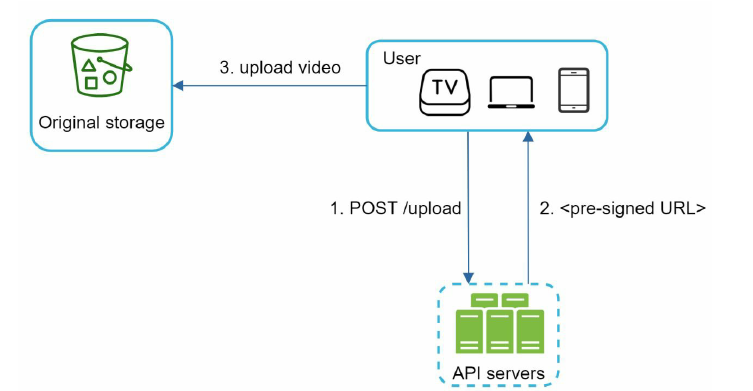
What Are the Core Components?
- Client (Web, iOS/Android, Smart TV)
- Load balancer → distributes requests to
- API servers (stateless, handle metadata, recommendations, auth)
- Metadata DB & cache (sharded MySQL + Redis)
- Original blob storage (raw uploads)
- Transcoding cluster
- Transcoded storage
- CDN edge (streaming delivery)
- Message queues (upload/transcode completion, notification)
Video Uploading Flow
Step‑by‑Step Breakdown
- Client fetches pre‑signed URL from API server.
- Client uploads chunks directly to blob storage.
- API server updates metadata DB/cache in parallel.
- Transcoding servers pick up raw files, process via DAG, store outputs.
- Completion handler updates metadata and pushes streams to CDN.
- API server notifies client: “Video ready for streaming.”
How Does Video Streaming Work?
Which Streaming Protocols Are Supported?
- MPEG‑DASH – adaptive bitrate streaming on most desktops.
- Apple HLS – required for iOS and Safari.
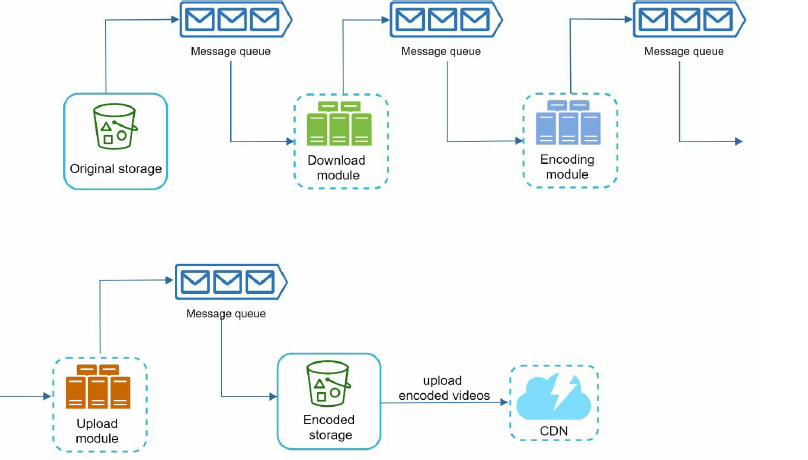
- Microsoft Smooth Streaming – legacy Windows devices.
- Adobe HDS – older Adobe‑based clients.
Edge Delivery via CDN
Edge servers cache transcoded segments close to users, minimizing latency and enabling instant playback.
Database Schema for Video Metadata & User Data
Videos Table (MySQL)
Column | Type | Description |
VideoID | BIGINT PK | Unique video identifier |
Title | VARCHAR(255) | Video title |
Description | TEXT | Detailed description |
Size | BIGINT | File size in bytes |
Thumbnail | VARCHAR(500) | URL of thumbnail |
UploaderID | BIGINT FK | Reference to Users.UserID |
LikesCount | BIGINT | Total likes |
DislikesCount | BIGINT | Total dislikes |
ViewsCount | BIGINT | View count |
UploadTime | DATETIME | Upload timestamp |
Indexes
- (VideoID, UploaderID) for fetching user videos
- Full‑text on (Title, Description) for search
Comments Table
Column | Type | Description |
CommentID | BIGINT PK | Unique comment ID |
VideoID | BIGINT FK | References Videos.VideoID |
UserID | BIGINT FK | References Users.UserID |
CommentText | TEXT | Comment content |
CreatedAt | DATETIME | Timestamp |
Indexes
- (VideoID, CreatedAt DESC) for recent comments
- (UserID, VideoID) for engagement analysis
Users Table
Column | Type | Description |
UserID | BIGINT PK | Unique user identifier |
Name | VARCHAR(255) | Full name |
VARCHAR(320) | Unique email for authentication | |
PasswordHash | VARCHAR(500) | Secure hashed password |
Address | VARCHAR(500) | Optional location |
Age | INT | Optional age |
RegistrationDate | DATETIME | Account creation timestamp |
Indexes
- (Email) for login
- (UserID, RegistrationDate) for analytics
Design Deep Dive
Video Transcoding
Why transcoding?
- Device compatibility (MP4, WebM, HLS, DASH)
- Adaptive quality (144p→4K)
- Storage efficiency (multi‑bitrate)
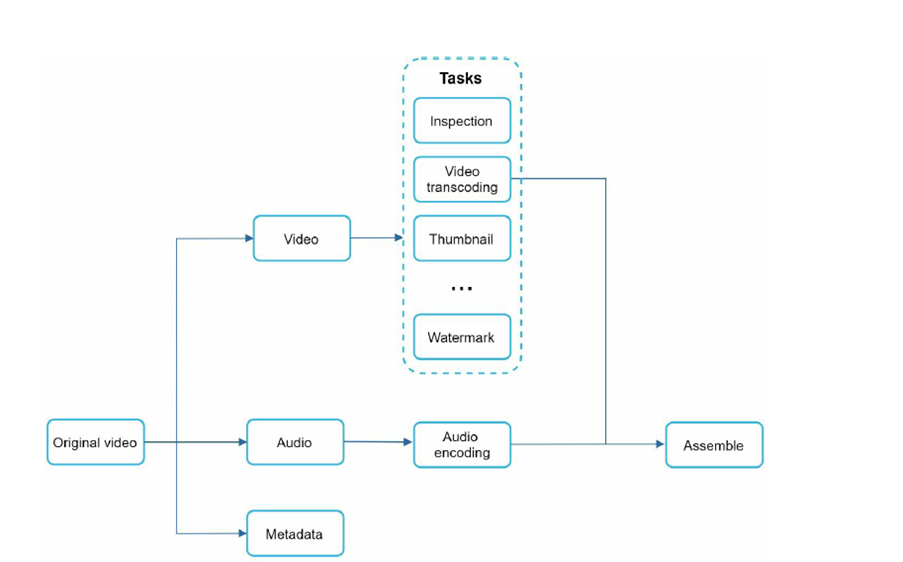
Common codecs & containers:
- Container: MP4, MKV, HLS TS
- Video codecs: H.264, VP9, AV1
- Audio codecs: AAC, Opus
Parallel Processing with DAG
Tasks—splitting, encoding, thumbnailing—are represented as nodes in a Directed Acyclic Graph, executed concurrently where dependencies allow.
Speed & Safety Optimizations
Chunked, Parallel Uploads
- GOP splitting on the client accelerates uploads and enables resumability.
- Global upload centers route to nearest edge point, reducing latency.
Secure Pre‑signed URLs
Clients upload directly to storage using URLs that expire, ensuring only authorized writes.
Optimizing Video Streaming Systems
Security & DRM
- DRM: FairPlay, Widevine, PlayReady.
- AES Encryption for protected streams.
- Watermarks to identify content ownership.
Cost‑Saving Techniques
- On‑demand encoding for infrequent videos.
- Regional CDN caching based on view patterns.
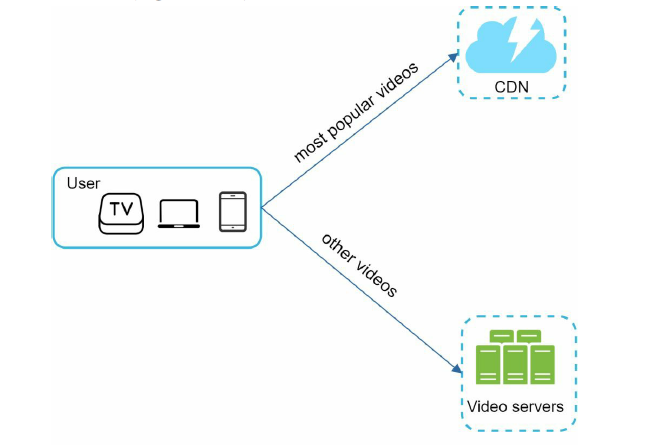
Custom CDN partnerships to lower bandwidth fees.
Error Handling & Reliability
- Retry logic for uploads and transcodes.
- Health‑monitoring load balancers that remove failed nodes.
- DB master‑slave failover and replicated caches (e.g., Redis).
Metadata Sharding Strategies
Shard by UserID
- Approach: Hash UserID → assign all user videos to same shard.
- Pros: Easy user‑centric reads.
- Cons: Hotspots for popular creators.
- Mitigation: Consistent hashing, dynamic repartitioning.
Shard by VideoID
- Approach: Hash VideoID → evenly distribute across shards.
- Pros: Balanced writes.
- Cons: Aggregation overhead for user feeds.
- Enhancement: Cache hot videos in Redis to minimize cross‑shard reads.
Wrapping Up: Designing Your Own Scalable Video Service
By combining:
- Pre‑signed URLs and chunked uploads for fast, secure ingestion
- DAG‑based transcoding for parallel, multi‑format output
- Global CDN for low‑latency delivery
- Sharded metadata + caching for high‑throughput reads/writes
- Cost‑saving measures (on‑demand encoding, regional CDNs)
you can architect a video‑platform that rivals YouTube in scale, reliability, and efficiency.
How do I master the core data structures and algorithms for technical interviews?
Start by building a strong foundation in arrays, linked lists, trees, graphs, sorting and searching techniques. Our DSA course offers hands‑on coding challenges, step‑by‑step explanations, and mock interview questions to help you ace your next interview.
What’s the fastest way to become a proficient full‑stack web developer?
Focus on both front‑end and back‑end technologies—HTML, CSS, JavaScript frameworks, RESTful APIs, and databases. Enroll in our Web Development course to learn modern stacks through real projects and mentorship from industry experts.
Should I combine system design principles with DSA practice or tackle them separately?
Integrating design patterns and algorithmic thinking accelerates your learning curve and prepares you for senior roles. Our Design + DSA Combined course merges system design workshops with algorithm deep‑dives for a cohesive experience.
Which program covers advanced system design alongside web development and DSA?
For a comprehensive curriculum that spans data structures, web frameworks, and large‑scale system architecture, check out our Master DSA, Web Dev & System Design course. It’s tailored for those aiming at high‑impact engineering roles.
How can I apply data science techniques to solve real‑world problems?
Learn how to preprocess data, build predictive models, and visualize insights using Python and machine learning libraries. Our Data Science course guides you through end‑to‑end projects and case studies to make your portfolio stand out.
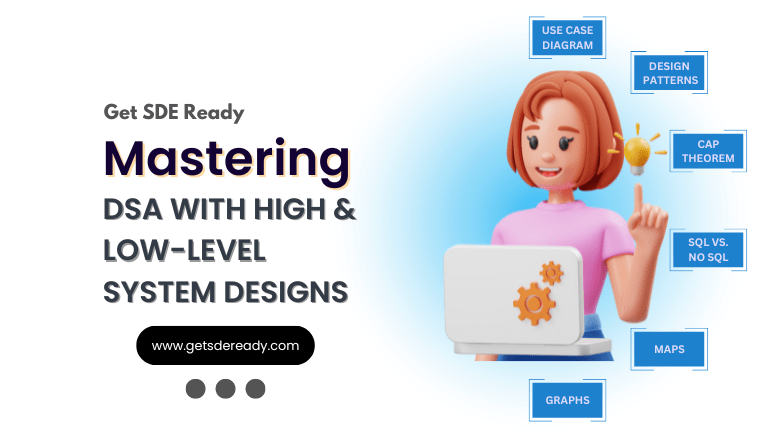
DSA, High & Low Level System Designs
- 85+ Live Classes & Recordings
- 24*7 Live Doubt Support
- 400+ DSA Practice Questions
- Comprehensive Notes
- HackerRank Tests & Quizzes
- Topic-wise Quizzes
- Case Studies
- Access to Global Peer Community
Buy for 60% OFF
₹25,000.00 ₹9,999.00
Accelerate your Path to a Product based Career
Boost your career or get hired at top product-based companies by joining our expertly crafted courses. Gain practical skills and real-world knowledge to help you succeed.
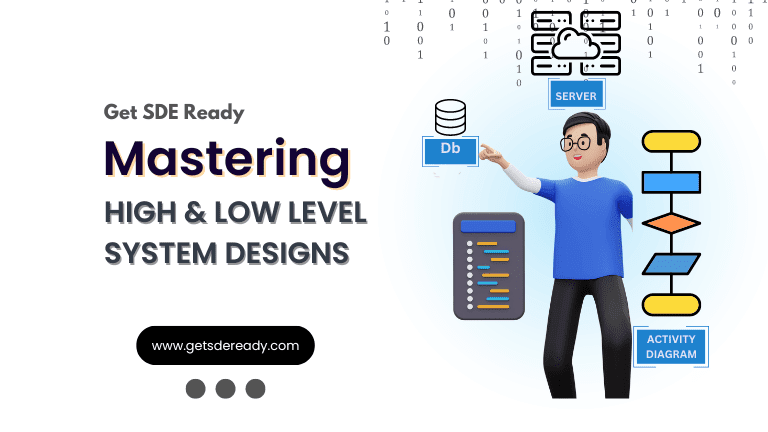
Low & High Level System Design
- 20+ Live Classes & Recordings
- 24*7 Live Doubt Support
- Case Studies
- Comprehensive Notes
- HackerRank Tests
- Topic-wise Quizzes
- Access to Global Peer Community
- Interview Prep Material
Buy for 65% OFF
₹20,000.00 ₹6,999.00

Fast-Track to Full Spectrum Software Engineering
- 120+ Live Classes & Recordings
- 24*7 Live Doubt Support
- 400+ DSA Practice Questions
- Comprehensive Notes
- HackerRank Tests & Quizzes
- 12+ live Projects & Deployments
- Case Studies
- Access to Global Peer Community
Buy for 57% OFF
₹35,000.00 ₹14,999.00

DSA, High & Low Level System Designs
- 85+ Live Classes & Recordings
- 24*7 Live Doubt Support
- 400+ DSA Practice Questions
- Comprehensive Notes
- HackerRank Tests & Quizzes
- Topic-wise Quizzes
- Case Studies
- Access to Global Peer Community
Buy for 60% OFF
₹25,000.00 ₹9,999.00

Design Patterns Bootcamp
- Live Classes & Recordings
- 24/7 Live Doubt Support
- Practice Questions
- Case Studies
- Access to Global Peer Community
- Topic wise Quizzes
- Referrals
- Certificate of Completion
Buy for 50% OFF
₹2,000.00 ₹999.00

ML & AI Kickstart
- Live Classes & Recordings
- 24/7 Live Doubt Support
- 2 Live Projects
- Case Studies
- Topic wise Quizzes
- Access to Global Peer Community
- Certificate of Completion
- Referrals
Buy for 50% OFF
₹2,000.00 ₹999.00

LLD Bootcamp
- 7+ Live Classes & Recordings
- Practice Questions
- 24/7 Live Doubt Support
- Case Studies
- Topic wise Quizzes
- Access to Global Peer Community
- Certificate of Completion
- Referrals
Buy for 50% OFF
₹2,000.00 ₹999.00
Reach Out Now
If you have any queries, please fill out this form. We will surely reach out to you.
Contact Email
Reach us at the following email address.
arun@getsdeready.com
Phone Number
You can reach us by phone as well.
+91-97737 28034
Our Location
Rohini, Sector-3, Delhi-110085
